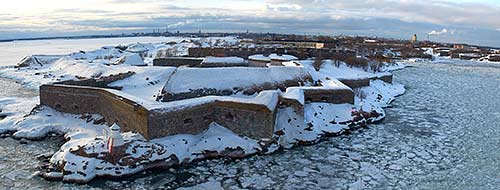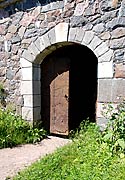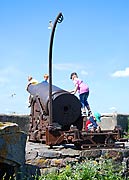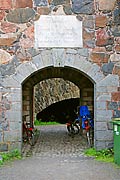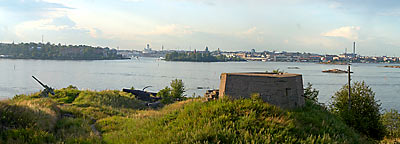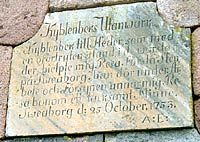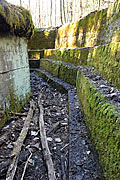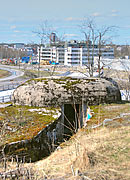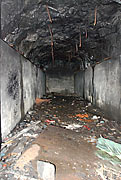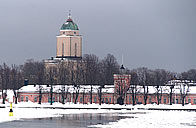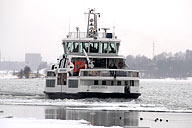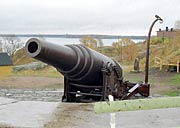Sveaborg fortress
(Suomenlinna, Viapori)
Construction of Sveaborg fortress began in 1748. It lasted more then 40 years instead of the planned 4 and was not completed in that kind what its designer Avgustin Erensvärd has conceived. The fortress referred as Sveaborg - i.e. the Swedish fortress. Finns named it Viapori.
Avgustin Erensvärd was an architect, ship builder, sea and artillery officer. There were only two passions in his life - Sveaborg fortress and coastal fleet. He died in 1774 and was buried in the fortress.
On May, 4, 1808 russian army besieged the fortress. Sveaborg was handed over after the short siege, despite of great superiority of Swedes in artillery (1000 guns against Russian 80). Only 5 men were missed in action from more then 8.000 garrison of fortress. The commandant admiral Kronshtedt has got under the tribunal with accusation of treason, and his relatives in Sweden were forced to change their surnames. In 1809 Finland became a part of Russian empire.
On August 6, 1855 the anglo-french fleet appeared under the walls of Sveaborg. There was the Crimean war of that time and the allies struggling against Russian empire decided to distract forces of the opponent. On August 9 bombardment began. Out of date fortress guns could not cause a great harm to allied fleet. Bombardment proceeded three days. There were big losses among garrison and vast destructions in the fortress.
Big reconstruction took place in the fortress at once after the Crimean war. New fortifications and artillery positions were constructed, more modern guns were established.
In 1906 there was a revolt of garrison of Sveaborg. The commandant of fortress arrested entire mine subunit for un subordination. There where strong riots in the Baltic squadron based in Revel on July 1906. In order to prevent of landing the revolutionary sailors on the islands of fortress, commandant ordered to put mines in entrance of Sveaborg's roadstead. The miners refused. Then they was surrounded and disarmed by infantry regiment. Gunners decided to release their comrades. Furious and bloody fight between gunners and two subunits of 1th Sveaborg fortress regiment was beginning of this well known revolt. The revolt was suppressed by fortress infantry regiment and ships of Baltic fleet.
During the WWI Sveaborg was part of the Fortress of Peter the Great and it was used as the base for mine fleet.
During the Civil war in Finland in summer 1918 the concentration camp for finnish Reds was here. A lot of them died here of starvation and illnesses. From that time the fortress refers as Suomenlinna ("Finnish fortress") and serves as naval base for the young finnish state.
In 1933 the warehouse of ammunition blew up and 12 men were killed.
During the Winter war the fortress was bombed by Soviet bomber forces with no essential success.
Nowadays Sveaborg is important cultural and museum centre, a lot of actors and artists live on the islands permanently. There are the Summer Theatre, Northern Institute of Modern Art, many museums and exhibitions and gallery. The finnish Venice - I can say.
Land defence of Sveaborg fortress
Idea about land defence of Sveaborg come in sight in 1907. First construction works begun only with the Great War beginning in 1914. More than 100 000 local wage workers and Russian solders were at the construction sites around Gelsingfors (Helsinki). Russian engeneers from Sveaborg coordinated these works. Final blueprint for the fortifications was adopted only in 1915.
Construction works begun to decline March 1917, whan the Revolution in St.Petersburg was held. January 27, 1918 Civil War in Finland broke out. German Baltic Division landed in Hanko and moved to Helsinki to help Whites drive out Reds from the capital. April 10 fight in Leppovaara was held and next day Reds fled to the east with loss of life.
After the war the installation were used yanf finnish Army for training purposes, but soon most of them where transfered to local authorities. Near to all metall was scarped and after that the installations were abandoned.
At present at least two strong points of the Sveaborg's land defence became a memorial zones. All others are abandoned, jvergrown and sometimes littered.
Impressions
It was coldly and sadly. The Baltic rainy weather with snow was there for the third day. It was empty and lonely on the ferry - only me, and a small group of ubiquitous japanese tourists in bright waterproof jackets.
For beginning of conversation I told one of them with Nikon F3 camera: " It is not a good weather for photograph today, sir, is it?"
- " Why? The weather is excellent today, I should say!" - the Japanese told and made round eyes - "This is the most suitable weather for photograph of the fortress!. And all other Japaneses (50 persons) made round eyes to in agreement and rushed on the left board to photograph that place in the grey drizzle where the fortress should be appeared.
And I have thought - he was right, this wise inhabitant of the country of rising sun. You should live at present and be happy! Today was the best weather for visiting Sveaborg. This day was the most suitable day for photographing! The wet boots was very useful things for additional contrast of sensations. The last 20FIM was enough for a cup of coffee. Another words - life was fine!
Such unexpected impressions have remained with me after visiting ancient swedish-russian-finnish fortress Sveaborg.
Land forts and fortress:
Bip Castle Gatchina Ivangorod Izborsk Kexholm Kirillov Monastery Koporye Novgorod Pechorskiy Monastery Peter&Paul Fortress Porkhov Pskov Schlisselburg Staraya Ladoga Tikhvin Vyborg Hameenlinna Hamina Kastelholm Kymenlinna Lappaenranta Raseborg Castle Savonlinna Tavetti Turku Visby Fredrikstadt Fredriksten Hegra Fort Hoytorp Fort Arensburg Narva Tallinn Antipatris Caesarea Jerusalem Latrun Fort Masada
Sea forts and fortresses:
Alexander Fort Ino Fort Krasnaya Gorka Fort Kronstadt: Kotlin isl. Kronstadt: North Forts Kronstadt: South Forts Trongsund Hanko Svartholm Sveaborg Marstrand Siaro Fort Vaxholm Oscarsborg
Artillery batteries and individual guns:
Coastal Artillery Hemso Fort
Fortified areas and defensive lines:
Karelian Fortified Area (KaUR) KrUR Leningrad Mannerheim Line Nevsky Bridgehead VT Line Harparskog Line Salpa Line Gothland
Russian
S e a r c h All news

